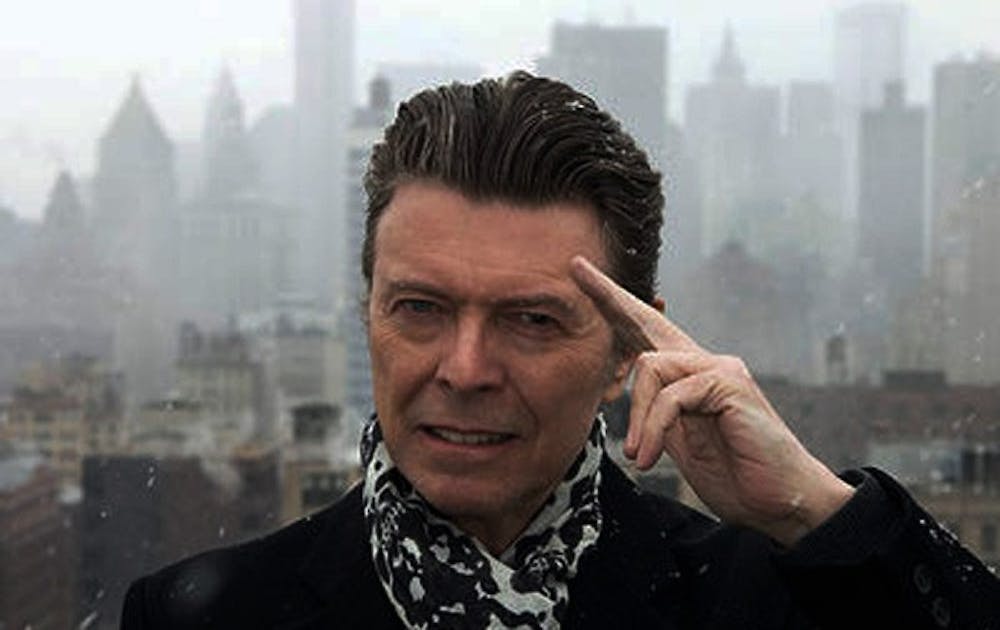If anyone has earned the right to indulge in perpetual existential crisis, it’s David Bowie. Simultaneously initiator and victim of pop culture trends of the last three decades, Bowie thrives in situations of ambiguous identity. Yet the irony of Bowie’s latest album The Next Day is that, for all the artist’s self-doubt, the record is most appealing for its references to the vast and varied Bowie legacy.
TND’s relationship to Bowie’s eclectic discography manifests in the LP cover art. The cover artist whited out the face of the album art of Bowie’s ’80s masterpiece Heroes and substituted the album’s title in minimalist font. If we take the symbolism seriously, Bowie seems to be writing over the ideas he developed in Heroes—and the rest of his anthology—after ten years of introspection.
For the most part, fans of Bowie’s classics can rest easy. Bowie has largely shed the pressure to overhaul his identity. Instead, the album relies on familiar Bowie sounds: rock backbeats from Diamond Dogs, funky saxophones riffs from Young Americans and the orchestrated ambience from the “Berlin Trilogy” all contribute to the album’s aesthetic. The characteristic squirming, high-register wail of Ziggy Stardust briefly appears in the chorus of “How Does the Grass Grow?”, and the R&B pep of “Fame” maintains a presence in the soulful backup vocals.
Some time periods, however, Bowie avoids altogether. There are no synthy industrial beats. TND is perhaps the diametric opposite to the electronic Earthling of 1997. Neither is the album a total conceptual detour like 1. Outside, though the second bonus track “Plan” rings of his experimental collaboration with Brian Eno. The tone is considerably less upbeat than Bowie’s previous album, 2003’s Reality. The consistent creative team, however, provides a sense of continuity with his past works. Guitarist Earl Slick, singer Gail Ann Dorsey and producer Toni Visconti all return after an eight-year hiatus post-tour, along with other Bowie vets. Their long experience as both an on-stage and studio group shines through. The production of TND, thank goodness, is no Tin Machine hodgepodge.
The mood, most importantly, has changed. The Next Day betrays an undercurrent of self-conscious fear, though not quite the post-cocaine melancholy of Low. Maybe the heart attack scare of Bowie’s luckless “A Reality Tour” shocked him with a sense of his mortality, or perhaps the experienced rocker is simply waxing philosophical in his late period. What was once bitter anxiety has matured into a full-bodied lament.
Like many great artists, Bowie broods about his legacy. Not that he’s run out of steam—TND doesn’t suggest creative exhaustion—but his high-energy, hyper-prolific ’70s and ’80s are certainly over. I’d even dare to suggest that there’s an embedded farewell to the public in the title track’s first stanza: “‘Look into my eyes,’ he tells her/ ‘I’m gonna say goodbye.” While Bowie is using a mouthpiece, more often than not Bowie’s third-person narratives give indirect clues to his personal life, and this continues to be true throughout TND. Other tracks hint that Bowie feels his age. “Where Are We Now,” an ethereal, minor-key dirge, speaks of uncertain futures for both Berliners and himself, contemplating life after the fall of the wall. The 2007 music video revisits Bowie’s apartment in Germany, revealing an artifact-ridden studio well befitting a “man lost in time.” The high-strung, elegiac “Love is Lost” mourns the loss of childhood bliss, when “It’s the darkest hour, you’re twenty two.” An error-message keyboard pulse and a strained, failing drumbeat communicate the angst of adulthood, when one must “wave goodbye to a life without pain.”
Of course, Bowie waved goodbye to a life of pain long ago. Low told us that he’s at least once been on the edge of the cliff, that he’s “Always Been Crashing In the Same Car.” But has Bowie really said “goodbye to the thrills of life?” I pray not. The first bonus track “So She” is a sign that Bowie is still joyful. The lighthearted, aquatic, bluegrass ballad sticks out in an album marked by confusion, and it’s a refreshing romance after “Heat,” the record’s lonely finale.
If for the past thirty years, Bowie has journeyed to and from the alternate universes of space rock, dancehall pop and ’90s industrial punk, The Next Day returns to earth. Bowie pauses briefly to orient himself, to contemplate where he’s been, to decide where he is now and wonder where he will stand in the future of rock and pop. He seems perfectly “content” if none of his questions are answered, as he tells us in the final bonus track “I’ll Take You There”: the question “What will I become in the USA?” is not as worrisome so long as he is “safe in this world” to “look up at the stars.”
Get The Chronicle straight to your inbox
Signup for our weekly newsletter. Cancel at any time.

